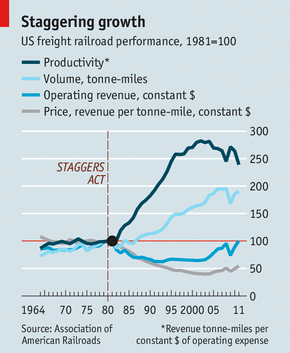A recent article by Diane Cardwell and Clifford Krauss in the New York Times suggests that new uses are growing that will limit any excess supply of natural gas and lead to cheaper and cleaner transportation options.
Natural gas driven vehicles have already made inroads in short-haul applications.
The big new development involves the investment in the infrastructure necessary to convert the long-haul diesel trucks to natural gas. This requires fueling facilities and cost-effective trucks capable of utilizing liquid natural gas (LNG).
"And in the latest sign of how the momentum for natural gas in transportation is accelerating, United Parcel Service plans to announce in the next few days that it will expand its fleet of heavy 18-wheel vehicles running on liquefied natural gas, or L.N.G., to 800 by the end of 2014, from 112. The vehicles will use the new Cummins engines, produced under a joint venture with Westport Innovations."
A significant move by truckers to LNG would have economic and environmental impacts.
"The move could also cut the country’s oil import bill. There are currently about eight million heavy and medium-weight trucks consuming three million barrels of oil a day while traveling the nation’s highways. That is nearly 15 percent of the total national daily consumption and the equivalent of three-fourths of the amount of oil imported from members of the Organization of the Petroleum Exporting Countries. Roughly two-thirds of the diesel used as transportation fuel nationwide feeds three million 18-wheelers, the main trucks hauling goods over long distances."
The main issues limiting the move to natural gas are the initial cost of the LNG-driven vehicles and the availability of fueling stations. The trucks cost about twice as much as a diesel vehicle, so the economic viability depends on how long it takes to recoup that investment. Here, there is significant difference in opinion. The authors quote a representative of U.P.S. that claims it takes seven to eight years to break even. Note that U.P.S. seems to think that is a cost effective time frame for them, but may be limiting to others.
Another opinion comes from a long-time investor in natural gas for transportation: T. Boone Pickens. He has teamed with Chesapeake Energy to form the company Clean Energy Fuels. Representatives of that organization provided a more sanguine view.
US energy officials are also projecting a rate of conversion to LNG.
The provision of sufficient LNG fueling sites to make this work would seem to require a prohibitive investment if it is required to overlay the grid of available diesel sites. Fortunately, that is not necessary. Here is an optimistic projection:
"’I promise you it will all fit together and the stations will be there,’ he said."
Pickens seems to be putting his money on the line—along with others.
"Clean Energy has plans to complete 30 to 50 more by the end of the year. Shell has an agreement to build refueling stations at as many as 100 TravelCenters of America and Petro Stopping Centers while ENN, a privately held Chinese company, hopes to build 500 filling stations as well."
These developments should create new jobs, stimulate new private investment, lower emission of green house gases, lower transportation costs, and improve our balance of payments problem. It is difficult to not be enthusiastic about this development.
An article in The Economist also indicates there is encouraging news coming from another transport sector—one that we do not normally think of as either innovative or growing: trains.
Apparently, while few have been paying attention, the railroads have been gearing up for a profitable future.
Even the present, with its hangover from the Great Recession, indicates a healthy industry.
This chart is provided to summarize the recent history of the railway freight industry.
The industry believes it will see increased demand for its services, and that it will better compete with long-haul trucking.
"Tony Hatch, a rail analyst, says improvements in scheduling and timekeeping mean that trains are now winning business they might not even have bothered bidding for before. Although railways cannot deliver to your door, as lorries can, Mr Hatch says big-box retailers are making more use of them because it is the cheapest way to move bulky things long distances over land."
"Moving goods by rail is four times more fuel efficient than by road, and railways can increase their capacity in the future. So America’s trains may soon nibble at trucks’ market share—particularly for journeys that take longer than a day by road."
One of the issues with new sources of energy is that they are emerging in areas in which the infrastructure to move them to where they can be processed is not available. One might build new, intrusive pipelines, or one might take advantage of the existing rail routes.
Here we have yet another development that promises lower fuel consumption and cheaper transportation costs.
Let’s appreciate good news when we are able to find some.



That is such a nice news, indeed. The more relief we can get from the environmental costs of certain fuels, the better. Who said that alternative fuel resource couldn't make the freight trains run faster or as they should? In my opinion, they will be more efficient, that's for sure, for the betterment of people in the long run, within the right circumstances. Anyway, thanks for sharing that! All the best to you!
ReplyDeleteKelly Hunt @ Triad Freightliner